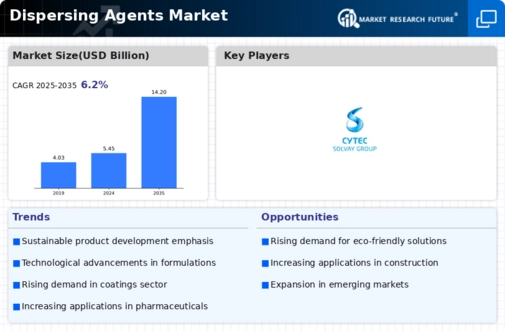Market Analysis
In-depth Analysis of Dispersing Agents Market Industry Landscape
The market dynamics of dispersing agents play a crucial role in various industries, including paints and coatings, pharmaceuticals, agriculture, and construction. Dispersing agents, also known as dispersants or dispersants, are chemicals that help in dispersing solid particles in a liquid medium, preventing them from clumping together. These agents improve the stability and performance of suspensions, emulsions, and solutions, making them essential additives in many products.
The growing development of manufacturing units and industries in the developing regions are expected to boost the market.
One key factor driving the dispersing agents market is the growing demand from end-user industries. With expanding applications in sectors such as paints and coatings, where dispersants are used to enhance pigment dispersion and paint performance, the demand for dispersing agents continues to rise. Similarly, the pharmaceutical industry relies on dispersants to improve the solubility and bioavailability of drugs, driving demand in this sector as well.
Moreover, technological advancements and innovations in dispersant formulations contribute to market growth. Manufacturers are constantly investing in research and development to create dispersing agents with improved performance, environmental sustainability, and cost-effectiveness. These efforts lead to the introduction of new and advanced dispersants, attracting customers and expanding market opportunities.
Globalization and increasing industrialization also play a significant role in shaping the market dynamics of dispersing agents. As industries expand globally and production volumes rise, the need for efficient dispersants becomes more pronounced. Additionally, stringent regulations regarding environmental protection and product safety drive the demand for eco-friendly dispersing agents that comply with regulatory standards.
Furthermore, competitive landscape and market consolidation influence the dynamics of the dispersing agents market. The industry is characterized by the presence of several major players, as well as numerous small and medium-sized enterprises (SMEs) competing for market share. Mergers, acquisitions, and partnerships among companies are common strategies employed to strengthen market position, expand product portfolios, and gain a competitive edge.
Price fluctuations of raw materials, such as surfactants and polymers, also impact the market dynamics of dispersing agents. Since dispersants are formulated using various chemical compounds, their prices are influenced by the cost of raw materials. Fluctuations in raw material prices can affect the overall production costs and pricing strategies of dispersing agent manufacturers, thereby influencing market dynamics.
Moreover, shifting consumer preferences and changing market trends contribute to the evolution of the dispersing agents market. As consumers demand products with improved performance, sustainability, and safety, manufacturers need to adapt their formulations and offerings accordingly. This drives innovation and product development in the dispersants industry, leading to the introduction of new and advanced products that cater to changing market needs.




Leave a Comment